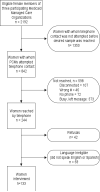Barriers to colorectal cancer screening among publicly insured urban women: no knowledge of tests and no clinician recommendation
- PMID: 22046852
- PMCID: PMC4083754
- DOI: 10.1016/s0027-9684(15)30414-4
Barriers to colorectal cancer screening among publicly insured urban women: no knowledge of tests and no clinician recommendation
Abstract
Objectives: To assess barriers to colorectal cancer screening among urban publicly insured women and to evaluate how barriers among underscreened urban women have changed between 2001 and 2007-2008.
Methods: Eligible women were selected using Medicaid Managed Care Organization (MMCO) administrative data. MMCO outreach staff interviewed women by phone between October 2007 and February 2008, and assessed their barriers to colorectal cancer screening. We compared the results of these interviews with interviews conducted in 2001 with women in community health center waiting rooms.
Results: Thirty percent of overdue women had never heard of either colonoscopy or sigmoidoscopy, and 55% had never heard of home fecal occult blood testing (FOBT). Among overdue women who had heard of colonoscopy or sigmoidoscopy, 33% reported misconceptions and 28% reported worry as a barrier. No clinician recommendation was the most commonly reported barrier to home FOBT (44%) and was also reported as a barrier to endoscopy by 22% of women. Between 2001 and 2007-2008, the proportion of women reporting that they had not received a clinician's recommendation for endoscopy or home FOBT increased significantly.
Conclusions: A lack of information, no clinician recommendation, misconceptions, and worry persist as barriers to colon cancer screening among this underscreened urban population. An increased focus on clinician recommendation and patient education about stool-based as well as endoscopic screening methods could lead to greater screening compliance.
Figures
Similar articles
-
Telephone outreach to increase colon cancer screening in medicaid managed care organizations: a randomized controlled trial.Ann Fam Med. 2013 Jul-Aug;11(4):335-43. doi: 10.1370/afm.1469. Ann Fam Med. 2013. PMID: 23835819 Free PMC article. Clinical Trial.
-
Colorectal cancer screening behavior in women attending screening mammography: longitudinal trends and predictors.Womens Health Issues. 2005 Nov-Dec;15(6):249-57. doi: 10.1016/j.whi.2005.06.001. Womens Health Issues. 2005. PMID: 16325138
-
Are we doing enough to screen for colorectal cancer? Findings from the 1999 Behavioral Risk Factor Surveillance System.J Fam Pract. 2002 Sep;51(9):761-6. J Fam Pract. 2002. PMID: 12366896
-
Colorectal cancer screening: scientific review.JAMA. 2003 Mar 12;289(10):1288-96. doi: 10.1001/jama.289.10.1288. JAMA. 2003. PMID: 12633191 Review.
-
Participation in colorectal cancer screening: a review.J Natl Cancer Inst. 1997 Oct 1;89(19):1406-22. doi: 10.1093/jnci/89.19.1406. J Natl Cancer Inst. 1997. PMID: 9326910 Review.
Cited by
-
The knowledge of colorectal cancer symptoms and risk factors among 10,078 screening participants: are high risk individuals more knowledgeable?PLoS One. 2013;8(4):e60366. doi: 10.1371/journal.pone.0060366. Epub 2013 Apr 3. PLoS One. 2013. PMID: 23573248 Free PMC article.
-
Increasing colonoscopy screening in disparate populations: Results from an evaluation of patient navigation in the New Hampshire Colorectal Cancer Screening Program.Cancer. 2017 Sep 1;123(17):3356-3366. doi: 10.1002/cncr.30761. Epub 2017 May 2. Cancer. 2017. PMID: 28464213 Free PMC article.
-
Participatory Research to Advance Colon Cancer Prevention (PROMPT): Study protocol for a pragmatic trial.Contemp Clin Trials. 2018 Apr;67:11-15. doi: 10.1016/j.cct.2018.02.001. Epub 2018 Feb 9. Contemp Clin Trials. 2018. PMID: 29408304 Free PMC article.
-
Telephone outreach to increase colon cancer screening in medicaid managed care organizations: a randomized controlled trial.Ann Fam Med. 2013 Jul-Aug;11(4):335-43. doi: 10.1370/afm.1469. Ann Fam Med. 2013. PMID: 23835819 Free PMC article. Clinical Trial.
-
Socioeconomic and physician supply determinants of racial disparities in colorectal cancer screening.J Oncol Pract. 2012 Sep;8(5):e125-34. doi: 10.1200/JOP.2011.000511. Epub 2012 Jul 3. J Oncol Pract. 2012. PMID: 23277775 Free PMC article.
References
-
- Steinwachs D, Allen JD, Barlow WE, et al. National Institutes of Health state-of-the-science conference statement: Enhancing use and quality of colorectal cancer screening. Ann Intern Med. 2010;152(10):663–667. - PubMed
-
- Holden DJ, Jonas DE, Porterfield DS, et al. Systematic review: enhancing the use and quality of colorectal cancer screening. Ann Intern Med. 2010;152(10):668–676. - PubMed
-
- Klabunde CN. Trends in the Use and Quality of Colorectal Cancer Screening in the US NIH State of the Science Conference. Bethesda, MD: 2010.
-
- Shavers VL, Jackson MC, Sheppard VB. Racial/ethnic patterns of uptake of colorectal screening, National Health Interview Survey 2000-2008. J Natl Med Assoc. 2010;102(7):621–635. - PubMed
Publication types
MeSH terms
Grants and funding
LinkOut - more resources
Full Text Sources
Medical


